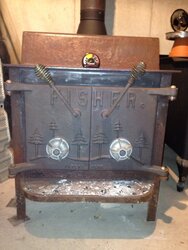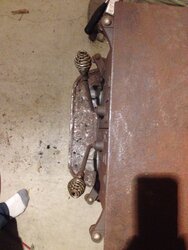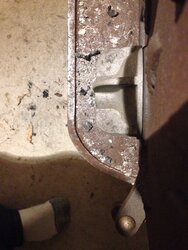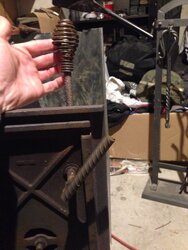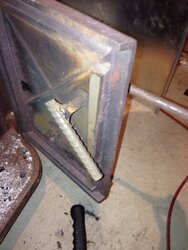How to run a grandma bear
- Thread starter Enplater
- Start date
-
Active since 1995, Hearth.com is THE place on the internet for free information and advice about wood stoves, pellet stoves and other energy saving equipment.
We strive to provide opinions, articles, discussions and history related to Hearth Products and in a more general sense, energy issues.
We promote the EFFICIENT, RESPONSIBLE, CLEAN and SAFE use of all fuels, whether renewable or fossil.
You are using an out of date browser. It may not display this or other websites correctly.
You should upgrade or use an alternative browser.
You should upgrade or use an alternative browser.
CamFan
Feeling the Heat
Lol I’ve never seen a piece of rebar added to a door handle. If you ever want to change it out I have new handles for that stove.
Hinges then gasket to fix it. Coaly does not like gasket on the old stoves because they did not come with it. But not all doors were hung correctly to maximize the air tight stove. Your choice.
Sent from my iPhone using Tapatalk
Hinges then gasket to fix it. Coaly does not like gasket on the old stoves because they did not come with it. But not all doors were hung correctly to maximize the air tight stove. Your choice.
Sent from my iPhone using Tapatalk
It's looking like I'll need a gasket to fix it. Seems like it'll be way more controllable if there is no leakage around the door seals. Almost 800 stove top degrees with the air knobs completely closed and pipe damper completely closed on a full load of wood doesn't seem normal to me. It wouldn't be possible with my englander, if I have a dry, full load of hard wood and a good draft I can close the primary air completely and watch the secondaries fire for a while before I need more primary air but I could not close the pipe damper all the way and expect to keep any flames.
CamFan
Feeling the Heat
View attachment 225189 A better look at the latch
Let me know when your ready to change it. Lol
Sent from my iPhone using Tapatalk
Oh my, send the poor guy a handle already.View attachment 225189 A better look at the latch
I actually installed gasket on my Goldilocks years ago. It wasn't due to leakage. My wife would get up to load the stove in the night and wake me with the clunk of the doors shutting. Very annoying it was.

CamFan
Feeling the Heat
Oh my, send the poor guy a handle already.
I actually installed gasket on my Goldilocks years ago. It wasn't due to leakage. My wife would get up to load the stove in the night and wake me with the clunk of the doors shutting. Very annoying it was.
Pm me. I think it’s not allowed to sell here.
Sent from my iPhone using Tapatalk
CamFan
Feeling the Heat
Pm me. I think it’s not allowed to sell here.
Sent from my iPhone using Tapatalk
I did not see it was you Coaly. Lol. Do you still have my email? You wanted some stuff I need to get to you
Sent from my iPhone using Tapatalk
DirtyhawaiianMD
New Member
Aloha All
Long time reader first time responding and new to the forum.
I also have a grandma bear it is my first wood stove. I have been researching and reading on the stove. I know mine is 1970 something there are no markings anywhere on the stove I combed it thoroughly. It had no gasket which I added but I'm planning on going with the flat next year. It now has the smallest rope like less then 1/4". It also did not have a baffle which I added I will explain process and materials later including photos. It did come with flue damper and Magic Heat exchanger which is awesome. All of which I use to heat my 1300 sq ft rancher home and it does a fantastic job of doing.
Thanks to all especially coally for giving outstanding advice and knowledge to those willing to learn.
Long time reader first time responding and new to the forum.
I also have a grandma bear it is my first wood stove. I have been researching and reading on the stove. I know mine is 1970 something there are no markings anywhere on the stove I combed it thoroughly. It had no gasket which I added but I'm planning on going with the flat next year. It now has the smallest rope like less then 1/4". It also did not have a baffle which I added I will explain process and materials later including photos. It did come with flue damper and Magic Heat exchanger which is awesome. All of which I use to heat my 1300 sq ft rancher home and it does a fantastic job of doing.
Thanks to all especially coally for giving outstanding advice and knowledge to those willing to learn.
Todd67
Minister of Fire
Aloha All
Long time reader first time responding and new to the forum.
I also have a grandma bear it is my first wood stove. I have been researching and reading on the stove. I know mine is 1970 something there are no markings anywhere on the stove I combed it thoroughly. It had no gasket which I added but I'm planning on going with the flat next year. It now has the smallest rope like less then 1/4". It also did not have a baffle which I added I will explain process and materials later including photos. It did come with flue damper and Magic Heat exchanger which is awesome. All of which I use to heat my 1300 sq ft rancher home and it does a fantastic job of doing.
Thanks to all especially coally for giving outstanding advice and knowledge to those willing to learn.
Welcome to the forum! I'm sure someone will be along to give you some tips and tricks on how to get the most out of your grandma bear.
DirtyhawaiianMD
New Member
That's the plan but for now I want to make this thing run correctly
Aloha All
I agree that a gasket wouldn't hurt my neighbor has the same woodstove and he swears by no gasket if it didnt come with one. I put one on only for testing purposes trial and error I mean if it works awesome and if not well I learned something. I see now why it is best to use the flat gasket in the stove channel versus the rope gasket in the door channel. The doors are slightly being pushed outward due to doors closing and the outer edges of the doors hit first which pushes on the gasket making the doors seem to push outwards. Maybe hurting the pins maybe not but again trial and error so if so to the store or internet for door pins.
I've also noticed that flue dampers are critical. I have spent the last 2 yrs trying to master the whole 8hr burn time and seemed to fail miserably every time. I have also learned that everyone operates there equipment differently so find you way but utilize the knowledge given in these posts from experienced professionals along with your methods tweak and perfect. This week I think I got it and excited I am. Adding the baffle inside did wonders more importantly it is kinda acts like a secondary burn. Instead of having the gases or smoke leave up the flue by forcing the unburned fuel back down and closer to the front of the stove where the oxy is. It ignites and thus secondary burn plus you get a hotter fire box which then more btu. I've tried every which way of placing the wood in the fire box and have noticed that N and S is the way my stove likes it and no other way.
Now to start I do the top down fire for less smoke and it works every time with zero smoke even on cold days. With the flue damper open and the doors on 2.5 or 3 I wait for my kindling and paper to fall igniting my stack. Once I have it lit I close the doors and allow the temp rise before making any further adjustments. Once flue temp and I mean the temp of my flue stack thermometer from the hardware store which is magnetic reaches 400 degrees which is in the optimal burn area. I open the right door and begin to start to close the flue damper once I start to see just the slightest bit of smoke coming back in the house then i know I am ready to close the door. After closing I wait and make sure the temp does not drop which it normally doesn't. As the temps start to rise I periodically close the door vents off evenly eventually to 1 or .75 turns from being closed. I now am in overnight mode which is what i call it i run it like this for 1 or 2 hrs while maintaining 400 to 450 degrees flue temp sometimes 350. Then before bed or work I load very large sometimes not even split logs into the fire and come home with mountains of coal. Keeping my house at a satisfying 73 to 75 degrees.
Yes is all of this poss making more creosote ?......
Maybe but then again I could just clean the flue more frequently and be a good wood stove owner and prevent disasters.
Last edited by a moderator:
Todd67
Minister of Fire
I heat with the mama bear in my avatar. When I load my stove I open the draft caps all the way before I open the door. I wait about a minute or less before I open the door. I remove ash if I need to, then I pull the coals toward the door and level them out. I add my wood and close the door. I leave my draft caps open all the way until my stove pipe thermometer reaches 400-500. I then close my draft caps all the way and open each one a 1/4 turn. That's how I run my stove all day and all night. I DONT have a flue damper. My creosote buildup is so low that I only clean my chimney once a year.
I live in a drafty, poorly insulated 2-story house in northern NY, and I've been using my mama bear for 7 years as my only heat source. I have a cieling fan in the living room that I leave running on the low setting, pushing air down, NOT pulling air up. My stove is in a corner of the living room. Having the ceiling fan on increases our heat output and burns less wood. Trust me, I've tried leaving the fan off or spinning it backwards and it doesn't work as well.
I live in a drafty, poorly insulated 2-story house in northern NY, and I've been using my mama bear for 7 years as my only heat source. I have a cieling fan in the living room that I leave running on the low setting, pushing air down, NOT pulling air up. My stove is in a corner of the living room. Having the ceiling fan on increases our heat output and burns less wood. Trust me, I've tried leaving the fan off or spinning it backwards and it doesn't work as well.
DirtyhawaiianMD
New Member
My flue pipe for my grandma bear as in my avatar has a 8 in flue pipe single inside then the thimble through the wall and up 20ft is triple wall from metafab. I did not want a smaller flue because from being a HVAC tech I know that restricting a pipe with heat increases velocity which I did not want to do and if the stove came with 8 then 8 it will be is what I decided.
Todd67
Minister of Fire
My flue pipe for my grandma bear as in my avatar has a 8 in flue pipe single inside then the thimble through the wall and up 20ft is triple wall from metafab. I did not want a smaller flue because from being a HVAC tech I know that restricting a pipe with heat increases velocity which I did not want to do and if the stove came with 8 then 8 it will be is what I decided.
There's nothing wrong with keeping the chimney at 8" to match the glue size.
When I first started heating with my Mama Bear I was trying to keep my single wall pipe above 250 all the time. But I have learned over the years that that is not as important as everyone makes it out to be, as long as you reach 400-500 every time you load the stove. Then we close the draft caps down to 1/4 or 1/2 turn. Our stove pipe thermometer goes back to the "cruising" temp until it's time to load the stove again.
This only works with properly seasoned wood. With greener wood you will need the draft caps opened more, and the temperature higher.
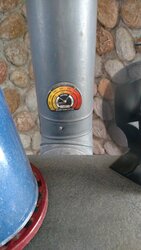
Well no you aren't going to keep it under 250 the whole time. But it should be for at least the first few hours. And yes despite what everyone says you need seasoned wood even for old stovesThere's nothing wrong with keeping the chimney at 8" to match the glue size.
When I first started heating with my Mama Bear I was trying to keep my single wall pipe above 250 all the time. But I have learned over the years that that is not as important as everyone makes it out to be, as long as you reach 400-500 every time you load the stove. Then we close the draft caps down to 1/4 or 1/2 turn. Our stove pipe thermometer goes back to the "cruising" temp until it's time to load the stove again.
This only works with properly seasoned wood. With greener wood you will need the draft caps opened more, and the temperature higher.
View attachment 238047
Get rid of the magic heat.Aloha All
I agree that a gasket wouldn't hurt my neighbor has the same woodstove and he swears by no gasket if it didnt come with one. I put one on only for testing purposes trial and error I mean if it works awesome and if not well I learned something. I see now why it is best to use the flat gasket in the stove channel versus the rope gasket in the door channel. The doors are slightly being pushed outward due to doors closing and the outer edges of the doors hit first which pushes on the gasket making the doors seem to push outwards. Maybe hurting the pins maybe not but again trial and error so if so to the store or internet for door pins.
I've also noticed that flue dampers are critical. I have spent the last 2 yrs trying to master the whole 8hr burn time and seemed to fail miserably every time. I have also learned that everyone operates there equipment differently so find you way but utilize the knowledge given in these posts from experienced professionals along with your methods tweak and perfect. This week I think I got it and excited I am. Adding the baffle inside did wonders more importantly it is kinda acts like a secondary burn. Instead of having the gases or smoke leave up the flue by forcing the unburned fuel back down and closer to the front of the stove where the oxy is. It ignites and thus secondary burn plus you get a hotter fire box which then more btu. I've tried every which way of placing the wood in the fire box and have noticed that N and S is the way my stove likes it and no other way.
Now to start I do the top down fire for less smoke and it works every time with zero smoke even on cold days. With the flue damper open and the doors on 2.5 or 3 I wait for my kindling and paper to fall igniting my stack. Once I have it lit I close the doors and allow the temp rise before making any further adjustments. Once flue temp and I mean the temp of my flue stack thermometer from the hardware store which is magnetic reaches 400 degrees which is in the optimal burn area. I open the right door and begin to start to close the flue damper once I start to see just the slightest bit of smoke coming back in the house then i know I am ready to close the door. After closing I wait and make sure the temp does not drop which it normally doesn't. As the temps start to rise I periodically close the door vents off evenly eventually to 1 or .75 turns from being closed. I now am in overnight mode which is what i call it i run it like this for 1 or 2 hrs while maintaining 400 to 450 degrees flue temp sometimes 350. Then before bed or work I load very large sometimes not even split logs into the fire and come home with mountains of coal. Keeping my house at a satisfying 73 to 75 degrees.
Yes is all of this poss making more creosote ?......
Maybe but then again I could just clean the flue more frequently and be a good wood stove owner and prevent disasters.
Todd67
Minister of Fire
Yes they do cool it to much they are horrible creosote factories@bholler , I always wondered if those heat reclaimers cool the chimney gases too fast. What's the good, bad, and ugly with them?
Todd67
Minister of Fire
Yes they do cool it to much they are horrible creosote factories
Thanks! I never considered one for my stove but I see people buying them. I chose my stove setup so that we could survive another ice storm like the one in 1998 that had people without power for up to 4 or 5 weeks, and that was January and February in northern NY!
You will be much better off if you just run the stove correctly to start with.Thanks! I never considered one for my stove but I see people buying them. I chose my stove setup so that we could survive another ice storm like the one in 1998 that had people without power for up to 4 or 5 weeks, and that was January and February in northern NY!
Todd67
Minister of Fire
I agree. I get long burn times, lots of heat, little to no smoke, and very little creosote in my Class A stainless chimney that I clean once a year. If I notice any smoke after I close down the draft caps, I open them again like I just reloaded the stove.
Last edited:
Similar threads
- Replies
- 9
- Views
- 3K
- Replies
- 1
- Views
- 794
- Replies
- 14
- Views
- 887
- Replies
- 23
- Views
- 2K


